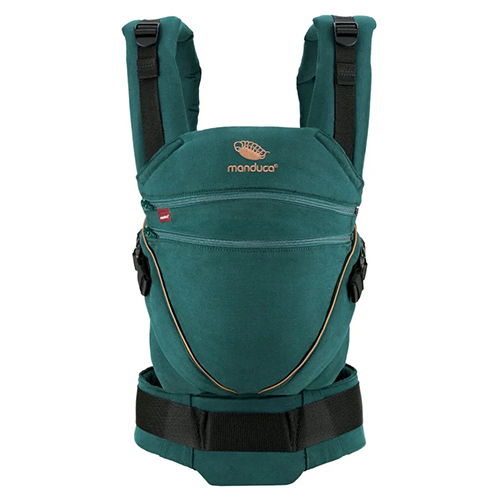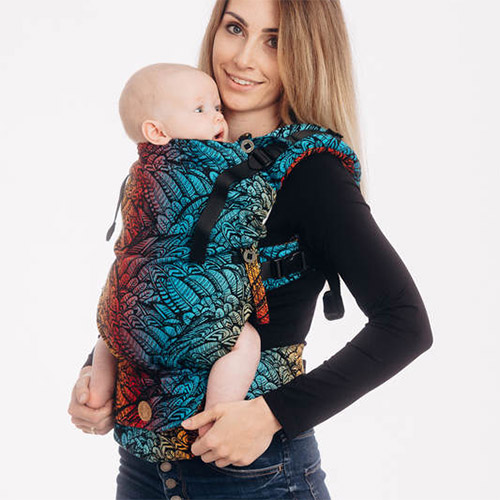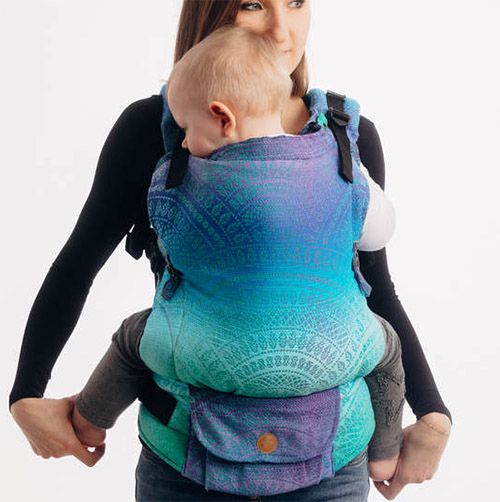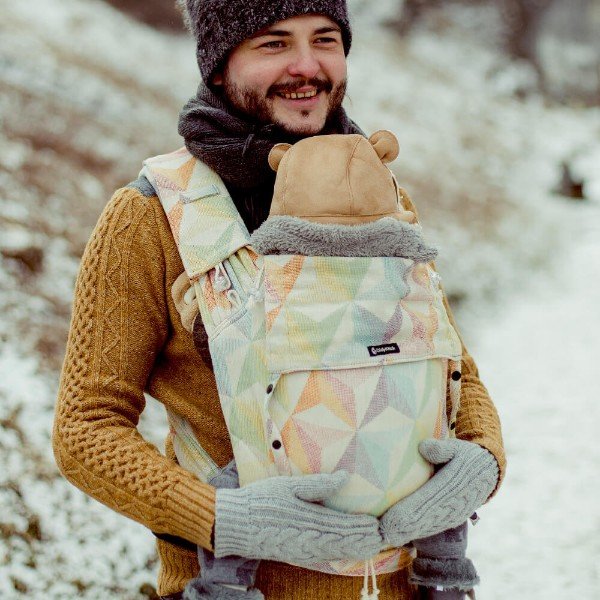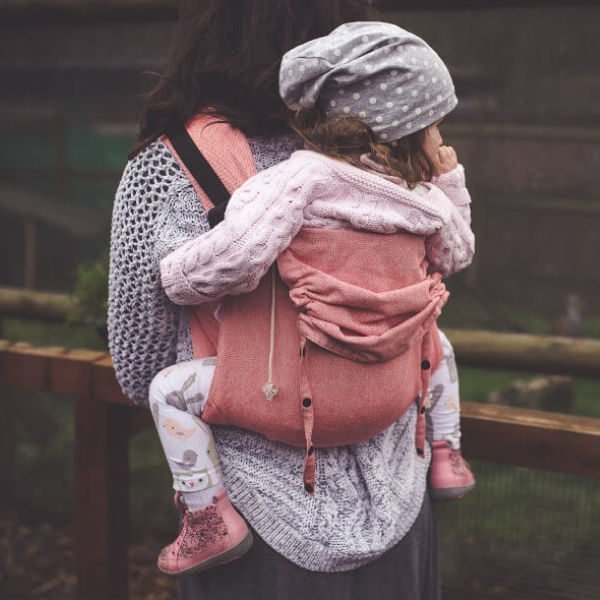What’s the best backpack carrier for your baby or toddler? Maybe you’ve got a carrier that’s been perfect for carrying your baby on your front, but now they’re getting taller and heavier and increasingly in the way. You may be feeling the weight more heavily on your shoulders, struggling to see over their head or even your own feet!
Back carrying is a great way for your bigger baby or toddler to share your experiences and view of the world, whilst giving you freedom to move and manage daily tasks easily. It’s also a more supportive alternative than outwards facing carrying on the front; your toddler can still see over your shoulder and for many parents back carrying is more comfortable on their back and shoulders than front carrying a bigger child.
Despite the practical benefits, back carrying is a parenting tool that many families just don’t use. This might be because it seems daunting, or simply that it just never occurs to you to try moving from front carrying, where you’ve been so comfy for so long.
When you think of baby back carriers, you might be thinking of a big, heavy, baby backpack carrier for hiking.
Many (taller) Dads love these, especially if they’re climbing up an actual mountain for a whole day. But these are simply too big and bulky for many mums(more on these below). The good news is, we can find you an easy, comfy, and more lightweight backpack baby-to-toddler carrier that will suit both mums AND dads; and that will double-up as a front carrier, too.
So how do you tell when your baby is ready to try back carrying? Is it safe? How easy is it to do by yourself? And what is the best baby backpack carrier?
We’re here to tell you what you really need to know about back carrying.
Is it safe?
As with all babywearing, yes it’s very safe, as long as it’s done properly! Make sure that your baby is held snug against your body so that they can’t flop or slump (or fling themselves) back or to the sides. A carrier that is too loose or too big won’t be supportive and will cause the weight to drag uncomfortably at your shoulders.
When can I carry them in a baby back carrier?
For many parents it’s easiest and safest to wait until your baby is strong enough to be able to sit up unaided, usually by around 6-8 months. By this age their spine will be stable and there’s less chance of them flopping around. If you are using a buckled carrier then do wait until your baby’s at least 6 months old.
However, if you really need or want to back carry a younger baby, then this is absolutely possible (and the norm in many cultures); it just takes a suitable wrap and plenty of practice to safely master the technique.
What makes a ‘Good’ Baby Back Carrier?
This actually varies from person to person. For most, getting a high back carry so that your baby is able to see over your shoulder will be most comfortable for you both. This will sit the weight around your upper back and reduce pressure on the shoulders. Carriers like the Manduca XT and Cococho are excellent options for a high back carry (more on our top-rated back carriers below).
However, some people prefer the weight to sit more onto their hips, in which case a lower back carry may be more comfortable. Be aware that a lower carry is likely to put more weight on your shoulders too. A low back carry may also mean that a smaller/shorter baby can’t see over your shoulders and so you may need to adjust the carry for when they’re awake and want to see around.
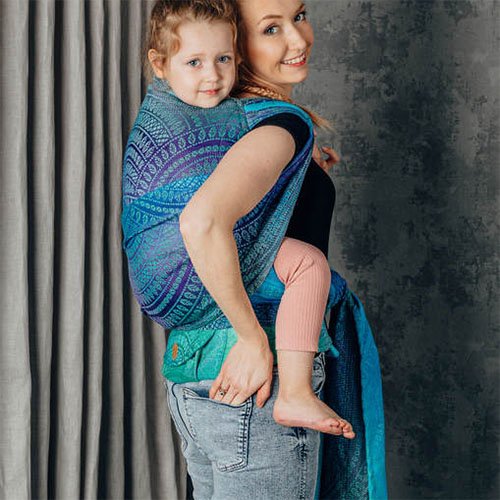
Won’t I need help to get them on?
This is the biggest barrier to back carrying; actually getting them up there! In almost all suitable wraps and carriers, it’s completely possible to get your child safely onto your back by yourself. Some carriers are easier than others; if you’re nervous try more structured options like a buckled carrier or meh dai. Woven wraps take more practice.
Practice first using a doll or baby substitute (pillow or a big bottle of water for the weight). Find some instructions that make sense to you – it may be worth watching a few different videos to see which you find most clear. Then practice practice practice until you feel confident. When you try with your baby, do either kneel on a bed, by a sofa, or have someone spot you.
If someone is spotting you while you practice unaided with your baby backpack carrier, don’t let them touch you, your baby or your carrier. It may seem counter-intuitive but in our experience, if someone else gets involved whilst you’re moving your baby around your body then you’re actually more likely to drop them.
Why? If you can feel how your baby’s weight is supported by your backpack carrier, then you have complete control over how you hold and move them safely. If someone else takes baby’s weight then you won’t be able to feel how they’re being supported by the carrier. So ask your helper to keep their hands off, but be ready to catch if baby does fall.
If you’d like professional help learning to back carry, then book in to see one of our experienced consultants who’ll be able to teach you how to do it safely and securely.
Scroll down to the bottom of this page for some more handy video tutorials and demos.
What if my baby doesn’t like it?
When you first try something new with a carrier it’s very normal for babies to fuss a bit. You’re likely to be a bit nervous; they’ll pick up on this and may feel uncertain about the new movements or new position behind you. The best thing to do is to get them supported safely on your back and get moving. Once you’re on the move, they can see everything going on and will quickly get over their initial worries.
Have I got the Right Carrier?
In order to carry your baby safely on your back, you need a sling or carrier that is suitable for back carrying. Some very popular carriers may be fantastic for front carrying but don’t always give the best fit for back carrying. You don’t want your baby so low they’re just staring at your spine, or to feel like your baby is hanging off your back.
Best Baby and Toddler Backpack Carriers
Buckled Carriers
Many quality multi-position buckle carriers now offer a back carrying option -so check the manual to see which positions are possible and whether your front carrier will convert to a back carrier. For buckled carriers, do wait until your baby is 6 months and/or sitting unaided.
Our Top-Rated Buckle Carriers for Back Carrying
Manduca XT – This super adjustable carrier is fantastic for back carrying and works well for pretty much everyone we’ve tried it on. Its perfect balance of softness and structure gives a snug and supportive fit without being bulky. It’s also brilliant for front carrying and genuinely fits from newborns to at least 3 years so you get all the options you need in one carrier. The Perfect Fit Adjusters – those are the little black straps you’ll find on the front of the shoulder straps – enable you to shorten the shoulder straps, giving you a really snug and high back carry, even if you have a more petite frame. Use code WEARMYBABY10 with Manduca for 10% off.
Cococho – Cococho’s new baby carrier makes back carrying easy and comfortable. Unlike most soft structured carriers, you load and secure baby into the carrier first, before putting the carrier on your chest or back. This gives you loads of reassurance when you’re getting to grips with back carrying and it’s a brilliant, lightweight alternative to a more cumbersome framed baby backpack carrier that’s really only great for hiking. It’s great for front carrying, too. You can use it from newborn, but it’s ideal from 3-4 months to at least 3 years.
Lenny Lamb Upgrade Carrier (newborn to 2-3years) and Lenny Lamb Preschool Carrier (15m – 7years+)
But Lenny Lamb carriers are the most luxurious, soft, supportive and beautiful ones around. Made in-house by the Lenny Lamb team in Poland, these really should be twice the price, they’re THAT good. We’ve tested them on mums from size 6 to size 24 and they work superbly (and on Dads too!).
They’re wonderfully supportive as a baby backpack carrier, and they’re heavenly for front carrying too. They cleverly lift and distribute your baby’s weight without being stiff or rigid. So they’re ideal if you’ve enjoyed the soft, snuggliness of your newborn wrap or sling. Like the Manduca XT, it’s another top choice for pretty much everyone – so long as you’re not bothered about having the option for outwards-facing.
Easy Feel Extend Plus – THE most long-lasting carrier on the market, this ingenious carrier adjusts to fit 12-18 month-olds up to age 7, 8 or 9y rs and beyond! Whilst most families won’t need to carry for this long, the Easy Feel Extend Plus is deliberately designed to consider families of children with additional needs. Made from strong-yet-soft woven Ikat cotton fabrics, this really is the ultimate carrier for comfort and longevity.
Tula Toddler Carrier – If your toddler is in age 2-3 clothes, they’re probably ready for the very brilliant Tula Toddler Carrier. With minimal adjustments, it works brilliantly as a straightforward back carrier for bigger kids up to age 4yrs+. It can be used on the front, too. With soft but supportive padding, your shoulders and back will be well looked after. Like the Manduca XT, the Perfect Fit adjusters make it a great option for all body shapes, from petite to plus size.
Izmi Toddler Carrier – this is a perfect option for parents who like the feel of tie-on carriers and wraps, but are looking for the reassurance of buckles. Suitable from 9months to 3years+, it’s soft and adjustable whist being easy and supportive. Compact enough to fit in your bag it’s ideal to have ready when your toddler gets tired, or to take travelling. It even offers a super comfy front carry and a convenient hip carry too.
What about the other big brand names?
There are, of course, lots of other buckled carriers that can be used on your back, and that may suit you really well. Ergobaby, Isara, Beco, Boba, Integra…. there are loads to choose from!
Woven wraps and Tie-On Carriers
Woven wraps offer a world of different tying methods; these definitely take more practice, but we found the extra effort is SO worth it. Our favourite back carrying ties include the Double Hammock, Rucksack Carry and Back Wrap Cross Carry. We love Didymos woven wraps for their reliably awesome wrapping qualities.
Meh Dais and Half Buckle Carriers are a bit more structured and actually just as easy as most buckled carriers for getting your baby on and off your back by yourself. As they have long shoulder straps you can get a much higher and snugger back carry than with most buckled carriers, as you can make them as tight as you like. This is particularly handy if you have a more petite frame and you’re finding that your buckled carrier just doesn’t go tight enough on your back.
Because they’re so much more adjustable than buckled baby backpack carriers, and won’t overspread your baby’s hips or legs, it is possible to use, woven wraps and many meh dais and half buckle carriers for younger babies (under 6 months) – though we’d only recommend doing this if you’re very confident as it can be trickier to get the hang of.
Onbuhimos and Podegis are great for back carrying too – especially if you want to carry while you’re pregant, as they have no waistband – but tend to be used for shorter periods.
We love using tie-on carriers like meh dais and woven wraps. These slings allow you to get a really snug, high back carry so whatever your shape your baby will have the perfect view over your shoulder.
Framed Baby Back Carriers for hiking – and Shoulder Carriers
We find that bigger framed, hiking backpack or shoulder carriers that you’ll find at outdoor stores, or MiniMeis G4, tend not to offer the versatility, support and practicality that many families need. If you are full-on hiking for a full day, carrying lots of extra kit, then they’re great! I like the Little Life range in particular. But framed baby backpack carrier won’t necessarily give the most supportive comfortable fit, particularly for smaller-framed or curvy parents. And if you’re average height or shorter the weight of the carrier itself and the high seating position for your child can make you feel off-balanced.
Yes, if you’re into hiking this style of carrier can be great, and your baby will be perched up high with a great view. But think walking boots verses trainers – for most families, for holidays and for day-to-day use – and for the versatility of offering different carrying positions – our advice is to go for a less bulky and more adjustable carrier like our favourites above.
Can I back carry in any other types of slings?
Whilst it’s possible to back carry in a pouch, ring sling and some ‘hybrid’ stretchy wraps, we’d not recommend these as your main back carrier. For these types of sling double check what’s recommended by the manufacturer, or seek advice from a carrying consultant.
Once you’re confident, then back carrying can give you and your little one a wonderful new and super easy way to explore the world together!
More Baby Back Carrier Demonstrations and Tutorials
Need help? Get in touch!
You can book a video consultation here. Live chat with us below, call 0345 222 9004, DM us on Instagram or info@wearmybaby.co.uk.
Always follow the TICKS guidelines for safe babywearing.
Updated February 2022.







 ⭐⭐⭐⭐⭐
⭐⭐⭐⭐⭐
